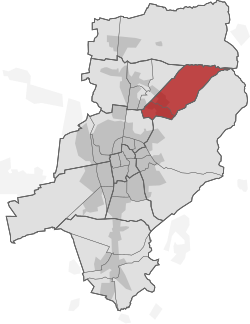Kranichstein | |
|---|---|
| Coordinates: 49°53′54″N8°40′37″E / 49.89833°N 8.67694°E | |
| Country | Germany |
| State | Hesse |
| Admin. region | Darmstadt |
| District | Urban district |
| City | Darmstadt |
| Area | |
• Total | 6.555 km2 (2.531 sq mi) |
| Elevation | 140 m (460 ft) |
| Population (2019-12-31) [1] | |
• Total | 12,043 |
| • Density | 1,800/km2 (4,800/sq mi) |
| Time zone | UTC+01:00 (CET) |
| • Summer (DST) | UTC+02:00 (CEST) |
| Postal codes | 64289 |
| Dialling codes | 06151 |
| Website | www |

Kranichstein is a district in the German city of Darmstadt. Housing construction in the area started in the 1960s and it now also has a number of residential high-rises. The district is often referred to as Darmstadt-Kranichstein.




